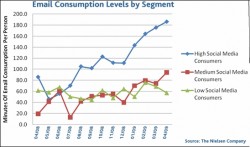How are you communicating with prospects? If you’re still using email, The Wall Street Journal says you are so last year.
The 1,800 word article begins, “Email has had a good run as king of communications. But its reign is over.” It goes on to argue that alternatives like Twitter, social media, texting, and other communications forms are eating into email’s dominance.
The most telling point in the article comes from Jeff Teper, a Microsoft VP, who says that email was overused in the past. “Now, people can use the right tool for the right task,” he says.
To put it another way, when all you have is a hammer, everything looks like a nail.
 Recruiters, however, should be wary of too quickly abandoning email. No less an authority than Nielsen, the user analytics company, says social media usage appears to actually increase email usage. Hitwise, another analytics and business intelligence firm, says Twitter’s usage may have hit a wall. Though it can’t count the number of Tweets being sent, indicators such as accesses to Twitter profile pages and on-site searches suggest the site “Twitter appears to have hit a resistance point as of April 2009.”
Recruiters, however, should be wary of too quickly abandoning email. No less an authority than Nielsen, the user analytics company, says social media usage appears to actually increase email usage. Hitwise, another analytics and business intelligence firm, says Twitter’s usage may have hit a wall. Though it can’t count the number of Tweets being sent, indicators such as accesses to Twitter profile pages and on-site searches suggest the site “Twitter appears to have hit a resistance point as of April 2009.”
The Nielsen review, a quick study to test the common belief that social media usage decreases email use, demonstrated the opposite. Blogged John Gibs, VP media analytics at Neilsen, “It actually appears that social media use makes people consume email more, not less, as we had originally assumed -– particularly for the highest social media users.”
That said, there are some generational differences in email usage. The Pew Internet and American Life Project found that teenagers have decreased their usage of email. Comparing usage in 2004 with that in 2008, the Pew survey discovered 73 percent of the teens using email at the end of last year versus 89 percent in 2004. One reason, of course, is the rise in texting during that period.
Contrast that with usage by Americans at the other end of the demographic scale. Says the report, “Fully 74 percent of Internet users age 64 and older send and receive email, making email the most popular online activity for this age group.”
Even so, the Pew report observes, “Instant messaging, social networking, and blogging have gained ground as communications tools, but email remains the most popular online activity.”
It is worth noting that while social media usage, generically, continues to grow, it is no guarantee that individual sites will. A year ago MySpace.com had two-thirds of the U.S. social media traffic. Today, it has less than a third, while Facebook’s share of the traffic tripled from 19.9 percent to 58.6 percent.
Meanwhile, time spent on MySpace declined 12 percent. On Facebook, it rose 23 percent.